
Ikari Warriors, known as Ikari in Japan, is a vertically scrolling run and gun video game released for arcades by SNK in 1986. It was published in North America by Tradewest. At the time there were many Commando clones on the market. What distinguished Ikari Warriors were rotary joysticks and a two-player cooperative mode. The rotary joystick controls were in turn based on SNK's earlier TNK III (1985). Ikari was originally intended to be an official licensed adaptation of the film Rambo: First Blood Part II (1985), but SNK were initially unable to acquire the rights to the film.

Operation Wolf is a light gun shooter arcade game developed by Taito and released in 1987. It was ported to many home systems.

Operation Thunderbolt is a light gun shooter video game developed by Taito and released for arcades in 1988. As the sequel to Operation Wolf, changes include two-player gameplay with two positional gun controllers mounted on the arcade cabinet, and a new forward-scrolling pseudo-3D perspective combined with side-scrolling sections.

Shock Troopers is a run and gun arcade game developed by Saurus and published by SNK in 1997 for the Neo-Geo arcade and home platform. Gameplay involves taking command of one or three soldiers in an eight-way shooter. A second game in the series, Shock Troopers: 2nd Squad, followed up in 1998.

The King of Fighters '98: The Slugfest, known in Japan as The King of Fighters '98: Dream Match Never Ends , is a fighting game released by SNK for the Neo Geo arcade and home consoles in 1998. It is the fifth game in The King of Fighters series. It was advertised by SNK as a "special edition" of the series, as it featured most of the characters who appeared in the previous games.

Alpha Mission, known as ASO: Armored Scrum Object in Japan, is a vertically scrolling shooter developed by SNK and released as an arcade video game in 1985 by Namco in Japan and Tradewest in North America. It was later ported to the Famicom in 1986 and released for the Nintendo Entertainment System in 1987.
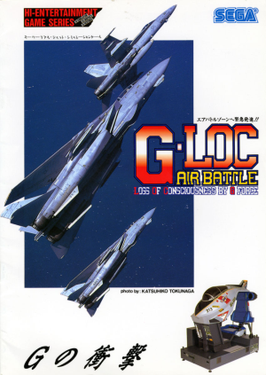
G-LOC: Air Battle is a 1990 combat flight simulator arcade video game developed and published by Sega. It is a spin-off of the company's After Burner series. The title refers to "G-force induced Loss Of Consciousness". The game is known for its use of the R360 motion simulator arcade cabinet. The arcade game was a commercial and critical success upon release.

Garou: Mark of the Wolves is a 1999 fighting game produced by SNK, originally for the Neo Geo system and then as Fatal Fury: Mark of the Wolves for the Dreamcast. It is the eighth installment of the Fatal Fury series.

Dark Arms: Beast Buster 1999 is an action role-playing game released by SNK for the Neo-Geo Pocket Color in 1999. It is a spin-off follow-up to the SNK arcade shooter Beast Busters. The game was later re-released as part of Neo Geo Pocket Color Selection Vol. 1 in 2021.
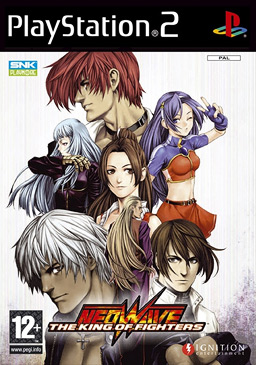
The King of Fighters Neowave(KOF Neowave, or KOF NW) is a 2D fighting game produced by SNK Playmore and released as a coin-operated arcade game for Sammy's Atomiswave hardware in 2004. It was the first game SNK Playmore produced for the Atomiswave. This is a remake of The King of Fighters 2002 with a major change of roster and stages, the game was also made on the PlayStation 2 and Xbox. The PS2 version was released only in Japan and the PAL region, the Xbox version was released both in Japan and North America. The North American version was released on April 18, 2006. In 2020, a Dreamcast homebrew adaptation of the arcade version was also made possible due to the Dreamcast sharing almost identical hardware with its Atomiswave cousin. The character artwork was done by Tomokazu Nakano. In Japan, it was the last game to be released for the Xbox.
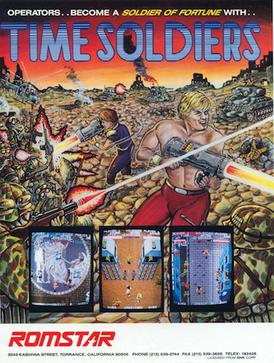
Time Soldiers, known in Japan as Battle Field, is a 1987 run and gun video game developed by Alpha Denshi for arcades and published by SNK. It was distributed in North America by Romstar. A Master System version was also produced, as well as versions titled Time Soldier for the Amiga, Commodore 64, and Atari ST.

Aliens is a 1990 run and gun video game developed and published for arcades by Konami. It is based on the 1986 film of the same title. Two players can play the game cooperatively in addition to single-player.

Space Gun is a 1990 first-person shooter arcade game released by Taito. The game is set aboard a crippled space station that has been overrun by hostile alien creatures. The objective is to rescue human crew members while destroying the alien creatures. The game lets the player shoot limbs off the creatures, resulting in blood splatters.
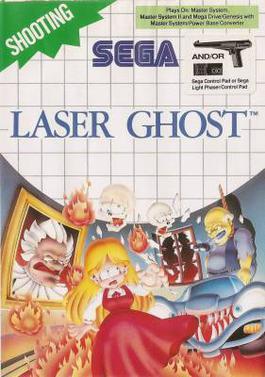
Laser Ghost is a horror-themed light gun shooter arcade video game released by Sega in 1990. The game is patterned after the films Ghostbusters and Poltergeist III, casting the player as a ghost hunter. There are three mounted guns set up on the cabinet, representing the three members of a ghost hunting team. The game puts the players in the role of Bill, Max and Carol, who must rescue a little girl kidnapped by a blue gargoyle, as well as protect the city from the ghost menace. A Master System game with the same title was released in 1991 exclusively for Europe, but was not based on the arcade original.
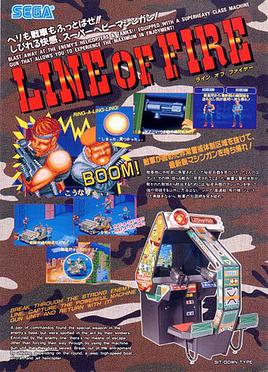
Line of Fire is a first-person light gun shooter game developed by Sega and released for arcades in 1989. It was released with two arcade cabinet versions, a standard upright and a sit-down cockpit, both featuring two positional guns. The cockpit design allows the player(s) to sit down while playing the game, while having two-handed machine guns, controlled by a potentiometer-controlled gun alignment software system. The game follows a two-man commando unit as they try to escape from a terrorist facility after seizing a prototype weapon.

Gun Buster, also known as Gunbuster (ガンバスター) and released in North America as Operation Gunbuster, is a first-person shooter video game developed by Taito and released for arcades in 1992. In contrast to on-rail light gun shooters at the time, this was one of the first arcade games to feature free-roaming FPS gameplay, the same year Wolfenstein 3D was released on personal computers.
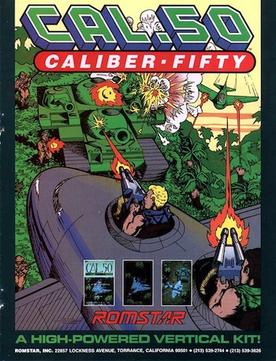
Caliber .50 is a 1989 scrolling shooter arcade game developed by SETA Corporation. A port of the game was released for the Sega Genesis in 1991.

Zombie Raid is a screen scrolling, horror-themed light gun shooter game released for the arcade by American Sammy in January 1995.

Resident Evil Survivor 2 – Code: Veronica is a light gun shooter video game developed and published by Capcom as part of the Resident Evil series. The arcade version was developed in conjunction with Namco for the arcade machines. The game was released for Sega NAOMI and PlayStation 2. It was released on the PlayStation 2 on November 8, 2001 in Japan and in Europe on March 22, 2002. Whilst the Playstation 2 release is a light gun shooter, the NAOMI arcade release features no lightgun technology whatsoever, instead deferring control of each player entirely to a three-axis joystick in the shape of a gun. The game is the second instalment in the Gun Survivor series and the sequel to Resident Evil Survivor. The game is adapted from Resident Evil – Code: Veronica and features enemies and characters from that game, and enemies from Resident Evil 2 and 3. It was followed by Dino Stalker which is a spin-off of Dino Crisis, and has no ties to Resident Evil.

Prehistoric Isle is a 1989 scrolling shooter arcade video game originally developed and published by SNK. Set during the 1930s, where ships at The Bahamas mysteriously disappeared, players assume the role of U.S. Marine pilots taking control of biplanes in a reconnaissance assignment at "Greenhell Isle", a fictional island inhabited by dinosaurs and creatures thought to be extinct. Headed by a director under the pseudonym of "Yah!", the game was developed by most of the same team that would later work on several projects for the Neo Geo platforms at SNK. Although first launched in arcades, the title has since been re-released through download services and compilations for various consoles. It received positive reception since its initial arcade release from critics who praised the visuals, sound design, gameplay and originality. A sequel, Prehistoric Isle 2, was released in 1999 for the Neo Geo MVS but garnered less success than its predecessor.





















